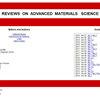Reinforcement mechanisms and current research status of silicon carbide whisker-reinforced composites: A comprehensive review
IF 3.9
4区 材料科学
Q2 MATERIALS SCIENCE, MULTIDISCIPLINARY
引用次数: 0
Abstract
In recent decades, with the advancement of micro-electro-mechanical systems technology, traditional materials have become insufficient to meet the demands of cutting-edge technology for various material properties. Composites have attracted widespread attention as an effective and viable solution. Silicon carbide whiskers (SiCw) have emerged as excellent reinforcements due to their high thermal conductivity, low thermal expansion coefficient, high melting point, superior mechanical properties, and high chemical stability. This article provides a comprehensive review of the reinforcement mechanisms and current research state of SiCw-reinforced composites. The reinforcement mechanisms include mainly grain refinement, load transfer, and crack bridging. The composites are categorized based on the type of the matrix: ceramic-based, metal-based, and polymer-based composites. The influence and parameter performance of the reinforcement mechanism on SiCw-reinforced composite materials with different matrices vary. However, the key to improving SiCw-reinforced composites lies in understanding the interplay of properties between the matrix and the reinforcement, as well as the ordered and regular distribution and binding at the interface. Finally, the current state and limitations of SiCw-reinforced composites are summarized, and future development trends are discussed. This article represents a great contribution to the future applications of SiCw-reinforced composite materials.碳化硅晶须增强复合材料的增强机理和研究现状:综述
近几十年来,随着微机电系统技术的发展,传统材料已无法满足尖端技术对各种材料性能的要求。复合材料作为一种有效而可行的解决方案引起了广泛关注。碳化硅晶须(SiCw)因其高导热性、低热膨胀系数、高熔点、优异的机械性能和高化学稳定性,已成为一种优秀的增强材料。本文全面综述了 SiCw 增强复合材料的增强机理和研究现状。加固机理主要包括晶粒细化、载荷传递和裂纹桥接。复合材料根据基体类型分为陶瓷基复合材料、金属基复合材料和聚合物基复合材料。不同基体的增强机制对 SiCw 增强复合材料的影响和参数性能各不相同。然而,改进 SiCw 增强复合材料的关键在于了解基体和增强体之间的性能相互作用,以及界面上有序、规则的分布和结合。最后,总结了 SiCw 增强复合材料的现状和局限性,并讨论了未来的发展趋势。这篇文章为 SiCw 增强复合材料的未来应用做出了巨大贡献。
本文章由计算机程序翻译,如有差异,请以英文原文为准。
求助全文
约1分钟内获得全文
求助全文
来源期刊

Reviews on Advanced Materials Science
工程技术-材料科学:综合
CiteScore
5.10
自引率
11.10%
发文量
43
审稿时长
3.5 months
期刊介绍:
Reviews on Advanced Materials Science is a fully peer-reviewed, open access, electronic journal that publishes significant, original and relevant works in the area of theoretical and experimental studies of advanced materials. The journal provides the readers with free, instant, and permanent access to all content worldwide; and the authors with extensive promotion of published articles, long-time preservation, language-correction services, no space constraints and immediate publication.
Reviews on Advanced Materials Science is listed inter alia by Clarivate Analytics (formerly Thomson Reuters) - Current Contents/Physical, Chemical, and Earth Sciences (CC/PC&ES), JCR and SCIE. Our standard policy requires each paper to be reviewed by at least two Referees and the peer-review process is single-blind.
 求助内容:
求助内容: 应助结果提醒方式:
应助结果提醒方式:


